

Internet 101. Academic Affairs - ADP Digital Polarization Initiative. The Digital Polarization Initiative, or “DigiPo”, is ADP's national effort to build student civic, information and web literacy by having students participate in a broad, cross-institutional project to fact-check, annotate, and provide context to the different news stories that show up in our Twitter and Facebook feeds.

DigiPo is spearheaded by ADP's inaugural Civic Fellow Mike Caulfield of Washington State University Vancouver. 502 Bad Gateway. Digital literacy is a hot topic these days, and we’ve previously written about the importance of it for today’s students and what teachers need to know about helping them use technology effectively to enhance modern communication.
But although the need for digital literacy is clear, actually teaching and using technology in educational settings can still be a bit of a puzzle. Of course, most students are already comfortable using a wide range of digital tools, but this doesn’t necessarily mean they know how to use these same tools for learning purposes. Inclusion facilitator Dr. Evaluating a Website or Publication’s Authority – Web Literacy for Student Fact-Checkers. Digitalliteracy.gov. Video: How to Search the Web Using Google - The Beehive. Stumped for a good restaurant to celebrate your wedding anniversary?
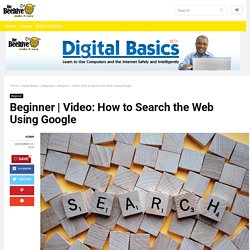
Curious about the weather in Instanbul? Interested in tracking down your family’s geneaology? Anything you can think of can be searched for on the internet! But the results can be overwhelming and confusing to sort through. If your search results in thousands of possible web pages, how do you know which one of those pages contains the information you need? There are so many search engines to choose from, but the most popular and widely used is Google. Step 1: Open your web browser in the Start menu.
Type www.google.com into your web browser’s URL box. Step 2: Use settings to filter your search results. Keep it clean. Step 3: Be general or specific with your search terms. Remember that the more specific you get with your search phrasing, the less web results you will yield. Example: I have some dishware that I need a replacement for. Step 4: Get specific results with search categories. Digitalliteracy.gov. Supercharge students' digital literacy skills with content curation - SCIS. While simple collecting is additive, curation is subtractive — what is left out is almost more important than what is included.

A great way to think about collection and curation is described by Frank Chimero (2011). Consider collection as a bowl of loose pearls, and curation as a pearl necklace. The individual pearls in the bowl may be of great value, but they are pretty useless when they are just gathered together. Curation is what happens when particular pearls are selected from the bowl and strung, in a particular order, into a beautiful necklace. The necklace has fewer pearls than the bowl but, as it can be publicly admired and worn, it may be considered to have more worth. How to Design Your Digital Citizenship Curriculum. Digital Literacy and Research Skills.
Jump to navigation 1 Hook - The Pacific Northwest Tree Octopus Ask students what a source is Somewhere you get information from (ex. books, online, news)Ask students how they know a source is reliable Website ends in .org, .edu, .govAuthors are visible, etc.Tell students that they are going to have 30 minutes to research about the Pacific Northwest Tree Octopus Student InstructionsStudents create a Google Slides presentation about the Pacific Northwest Tree Octopus What is it?
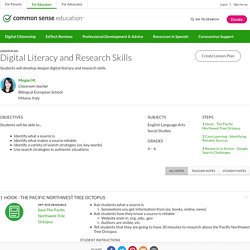
Where does it live? 8 digital skills we must teach our children. The social and economic impact of technology is widespread and accelerating.
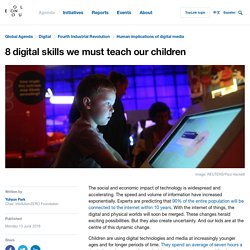
The speed and volume of information have increased exponentially. Experts are predicting that 90% of the entire population will be connected to the internet within 10 years. With the internet of things, the digital and physical worlds will soon be merged. These changes herald exciting possibilities. But they also create uncertainty. What Your Students Really Need to Know About Digital Citizenship. In my classroom, I use two essential approaches in the digital citizenship curriculum that I teach: proactive knowledge and experiential knowledge. Proactive Knowledge I want my students to know the “9 Key Ps” of digital citizenship. While I go into these Ps in detail in my book Reinventing Writing, here are the basics: 1.
Video Lesson: Digital Footprint. Young & eSafe · Home. Classroom resources. Tim Berners-Lee on the future of the web: 'The system is failing' Sir Tim Berners-Lee’s optimism about the future of the web is starting to wane in the face of a “nasty storm” of issues including the rollback of net neutrality protections, the proliferation of fake news, propaganda and the web’s increasing polarisation.

The inventor of the world wide web always maintained his creation was a reflection of humanity – the good, the bad and the ugly. But Berners-Lee’s vision for an “open platform that allows anyone to share information, access opportunities and collaborate across geographical boundaries” has been challenged by increasingly powerful digital gatekeepers whose algorithms can be weaponised by master manipulators. “I’m still an optimist, but an optimist standing at the top of the hill with a nasty storm blowing in my face, hanging on to a fence,” said the British computer scientist. “We have to grit our teeth and hang on to the fence and not take it for granted that the web will lead us to wonderful things,” he said. “The system is failing.
Nine Elements. Nine Themes of Digital Citizenship Digital citizenship can be defined as the norms of appropriate, responsible behavior with regard to technology use. 1.
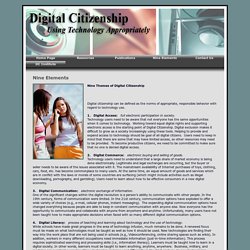
Digital Access: full electronic participation in society. Technology users need to be aware that not everyone has the same opportunities when it comes to technology. Getting Sneaky About Digital Citizenship – DigCit Institute. Article reposted with permission from nancywtech.com Dear Teachers, I met with a librarian friend of mine today to brainstorm ways to get digital citizenship embedded in lots of different areas of her school.
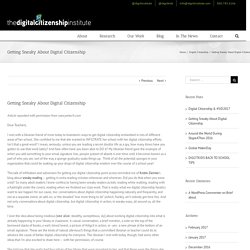
She confided to me that she wanted to INFILTRATE her school with her digital citizenship efforts. Isn’t that a great word? 10 Digital Citizenship Resources. Nine Elements.
Truth or Fiction. InCtrl. Digital Citizenship in Education and the Classroom. Tomorrow, I am attending a workshop, the objective of which is to develop a curriculum focused upon digital citizenship.
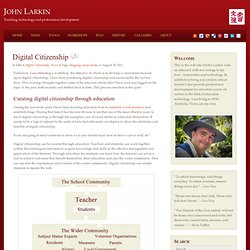
I have been pondering digital citizenship and social media the last few days. This evening I brought together some of the relevant articles that I have read and tagged on the topic in the past, both recently and further back in time. This process resulted in this post. SWGfL Digital Literacy - Home. 21st Century Fluencies. The Essential Fluencies The Essential Fluencies of innovative learning are structured processes for developing the skills that your students need to succeed, today and in the future.
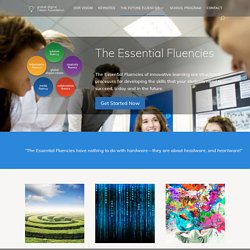
Get Started Now “The Essential Fluencies have nothing to do with hardware—they are about headware, and heartware!” Solution Fluency Develop problem-solving superpowers Learn More. Digital citizenship / Teaching. Netsafe – Learn Guide Protect The myLGP website supports the Learn Guide Protect Framework . The site promotes a student-centred approach to teaching and learning about cybersafety and digital citizenship across the curriculum. Developed by NetSafe, in collaboration with New Zealand teachers. NetSafe kit for schools A comprehensive programme of cybersafety for schools based upon infrastructure of policies, procedures and use agreements, an effective electronic security system, and a comprehensive cybersafety education programme.
Netsafe – Staying safe online A quick guide with advice, tips and how-to guides for social media, online shopping, safe search and more. NetSafe – Learn Guide ProtectSean Lyons, Chief Technology Officer from NetSafe, explains the Learn Guide Protect (LGP) website. Scope & Sequence. Get Trained Use our professional development resources to learn best practices for teaching digital citizenship to your students. Onboard Students: Digital Passport Introduce students in grades 3-5 to Digital Passport, our award-winning suite of games that help onboard students to the foundational skills of digital citizenship and Internet safety. Teach Lessons: Unit 1 Teach Lessons: Unit 2 5 - Picture Perfect How can photos be changed on the computer, and how can that affect your feelings about the way you look?
Digital Citizenship Week. Ask your students to create their own pledges.How can your students become super digital citizens? Ask them! Begin by encouraging your kids to write their own personal pledges about being good digital citizens in their everyday lives. A pledge could take the form of a motto or a slogan, a song, or a rap. It can rhyme, but it doesn't have to.Download our Student Pledge Activity Sheet and share it with your students to get them started. Educational Technology and Mobile Learning: 10 Great Digital Citizenship Lessons from Google.
July 15, 2014 Today I want to draw your attention to these excellent resources from Google. Common Sense Media. Global Digital Citizenship by Sonya Van Schaijik. Home - eSmart Digital Licence. A Treasure Trove of Digital Citizenship Resources for Teachers. Via Educational Technology and Mobile Learning. Global Digital Citizen Foundation. Digital Compass.
Digital Bytes. Interactive Assessments. Digital Passport by Common Sense Media.